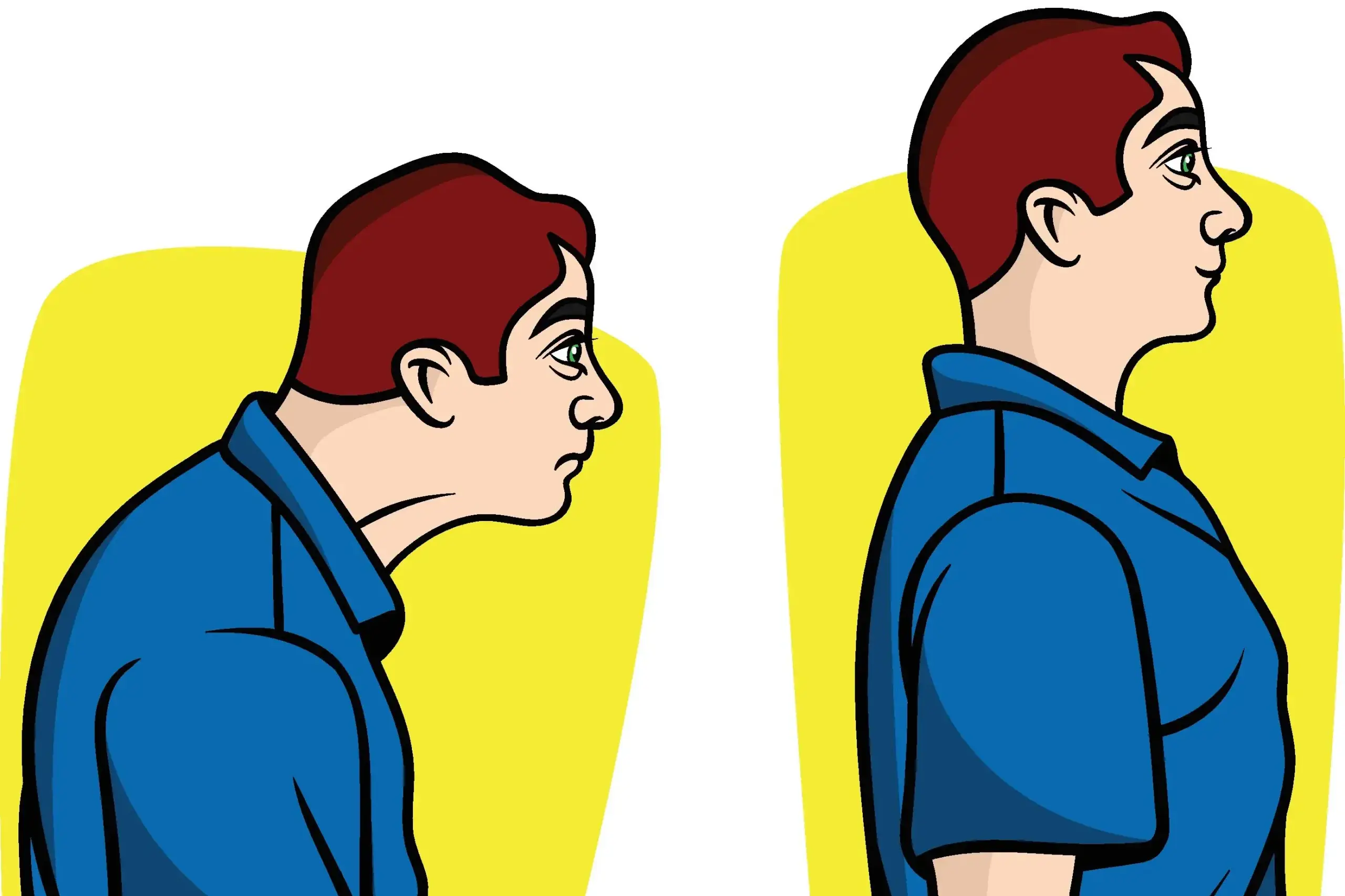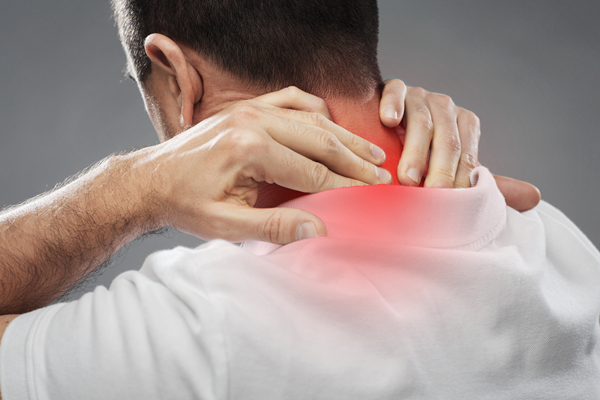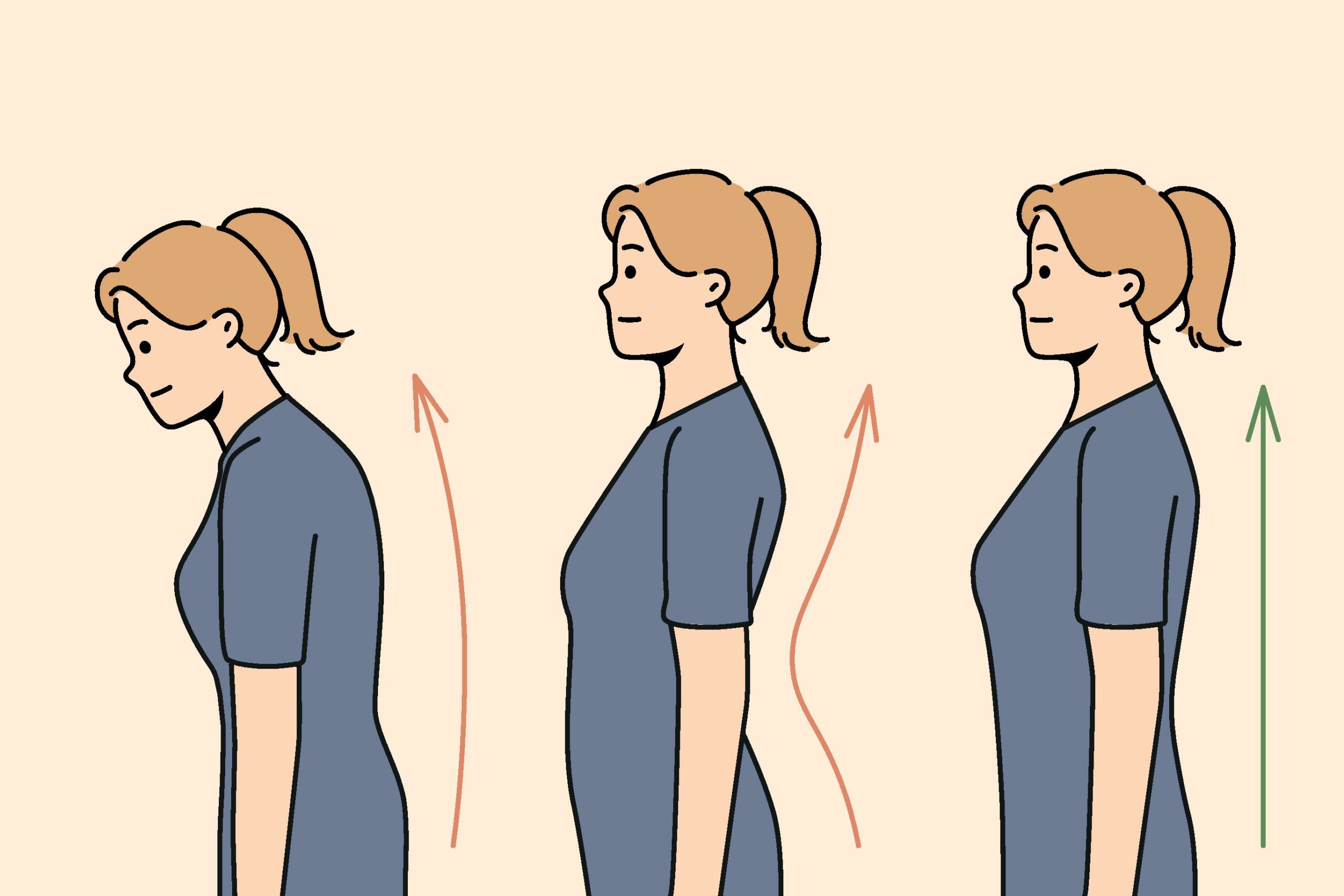The back of neck hump that some women develop is called Dowager’s hump. It is an increased curve that develops in the upper back (thoracic spine), just below the curve of the neck. While the back of neck hump can develop in both men and women, it is more commonly seen in older women. The term ‘Dowager’ is a historical reference to a widow with an inheritance from her deceased husband.
Medically called a hyperkyphosis, the back of neck hump is typically caused by too much time spent leaning over in a “hunched” position. Once upon a time, that was due to spending too much time performing tasks like sewing, cooking, or washing clothes. Now computer screens, phones, and tablets are more likely to be blamed. Over time, this poor posture can cause you to develop an increased and abnormal upper back curve.
Table of Contents
ToggleWhat is a Dowager’s Hump?
Kyphosis describes the forward curve of the spine. Many websites describe kyphosis as “abnormal,” but the thoracic spine naturally has a mild forward curve. A similar condition occurs in the lumbar and cervical spine, just in the opposite direction. This “backward” curve is called lordosis and is also normal. Either of these curves is abnormal when they are exaggerated. These natural curves are crucial for good posture and vital for spine flexion and extension. If you have a back of neck hump or hyperkyphosis, you may experience one of these unwanted conditions, including:
- Rounded shoulders
- Tight hamstrings
- Pain or stiffness in your back and shoulder blades
- Extreme fatigue
- Headaches or migraine
Extreme examples of hyperkyphosis can cause severe problems like:
- Impaired lung function
- Reduced mobility
- Increased mortality (due to cardiac and pulmonary conditions)
How do you know if you have a dowager’s hump? Take a look at your profile in the mirror. Your back may appear rounded (hence why some call it hunchbacked), and your head juts forward.
Often, a dowager’s hump is mistaken for a “buffalo hump,” a condition that has a similar appearance. A buffalo hump is typically a symptom of a hormonal issue called Cushing’s disease. Symptoms of Cushing’s disease tend to appear around the ages of 30 to 40. When the body produces too much of the hormone cortisol, it can lead to increased fat production in isolated areas, creating a back of neck hump.
What Causes a Back of Neck Hump?
Poor posture is the most common cause of the back of neck hump. Weakened muscles of the upper back and neck and tight, shortened muscles in the neck and chest are often to blame for this type of poor posture.
Other possible causes of a Dowager’s hump include:
- Postural Changes: One of the most common causes of this specific type of poor posture can be connected to long periods of time hunched over cell phones, tablets, and laptops. Repeatedly assuming this forward flexion position stretches the muscles, ligaments, and tendons, as well as compressing the intervertebral discs in the upper back and neck.
- Osteoporosis: A compression fracture causes an increased forward curve. This causes your upper back to curve more, forcing you to lift your neck into more extension to see forward. It’s those two factors that cause the bump in the upper back. Women are more likely to develop a Dowager’s hump, as hormone changes during menopause increase their risk of bone loss due to osteoporosis.
- Degenerative changes: As we age, there are slow, progressive changes in the spine’s normal structure and function. They range from mild to severe and most often result from the normal aging process. Arthritis, tumors, and infections can also cause these changes.
- Underlying bony or ligamentous changes: Spinal infections, fractures, tumors, calcifications of spinal ligaments, and other bony or ligamentous pathologies can also change the shape of your spine.
- Congenital problem: Less frequently, the spine needs to form correctly before birth.
- Scheuermann’s kyphosis: This shows up in teenagers when one of the vertebrae in the spine fails to develop properly. Instead of forming a stable rectangle shape, the anterior (front) portion does not grow as quickly, resulting in a wedge shape instead of a rectangle.
Lump on Back of Neck Spine Treatment
A full-body adjustment chiropractor will perform a specific chiropractic adjustment to correct vertebral subluxations (misalignments) that contribute to poor posture by affecting the spine’s natural curves. Specific chest stretches and strengthening exercises for the mid and upper back can improve posture by addressing muscle imbalances. For those seeking reassurance, wearing a posture shirt can significantly align the shoulders and head with the rest of the body. The ear, shoulder, hip, knee, and ankle must align straight when standing for optimal posture.
Furthermore, Acupuncture and Dry Needling offer additional benefits by relieving muscle tension, reducing pain, and promoting blood flow, which can enhance the effectiveness of these posture-correcting practices. This can bring relief and comfort, making the journey to better posture more manageable and less daunting.
Exercises to Get Rid of the Back of Neck Hump
Depending on your age and the severity, you often can improve or reverse a Dowager’s hump. You can accomplish this by strengthening your upper back and neck muscles. Increasing muscle tone helps pull up your shoulders and head.
The following exercises can be very helpful:
Chin Tucks. To do a chin tuck, pull your chin straight back. This is good for the disks in your neck and strengthens your neck muscles.
Scapular Squeezes. For these, squeeze your shoulder blades together, which helps improve your upper back muscles. Do three sets of 10 daily.
Doorway Pectoral Stretches. Stand in an open doorway, raising your arms like a goalpost with your palms forward. Place your palms on the door frame and step forward with one foot to feel the stretch across your chest. Hold for 20 to 30 seconds. Do it two to three times daily.
These exercises require little time and no special equipment. Dutifully performing them just three times a week can create a noticeable change in posture.
How to Prevent the Back of Neck Hump
As noted above, spending too much time bent forward or looking down creates extra strain on the upper back and neck. Practicing good posture and maintaining an ergonomic workstation (while taking regular breaks), helps to prevent and even reverse this common postural problem.
It is essential, especially for women, to maximize your hormone health and focus on good nutrition to avoid developing osteoporosis. Vertebral fractures resulting from poor bone density can cause an increased forward curve in the upper back.
Practicing good posture is also a vital habit to maintain if you want to avoid developing a back of neck hump. Most importantly, many of us should consider our posture when using cell phones or laptops. Keep your cell phone at eye level to avoid flexing the neck forward too far. It would help if you also were sure to limit the time you spend on your phone or any electronic device. Taking regular breaks will help you avoid developing a back of neck hump.
If you are beginning to develop a back of neck hump, contact Integrative Health and Rehab today. Waiting to address early signs of a back of neck hump will only make treating this condition harder.
Exercise Alone May Not Be Enough
Need more help managing your back pain? Contact us! We will give you honest answers to what is causing your pain and what we can do to help you. If we don’t think Acupuncture, Chiropractic Adjustment, Dry Needling, or Shockwave Therapy will help your specific problem, we’ll tell you! Still not sure if we can help? Please read some of our 5-Star reviews and see what patients have to say. The Denver chiropractor at Integrative Health and Rehabilitation has been helping patients in Arvada, Denver, Mountain View, and Wheat Ridge, Colorado, for over 25 years. Learn more about the conditions we treat on our Health Articles page.
Ready to start feeling better? Book an appointment online to learn why we are the affordable chiropractic clinic Denver seeks for fast, effective, and lasting pain relief.
*Thank you to physitrack.com for allowing the use of their videos!

Ready for an expert opinion? Get in touch today!
With a legacy of more than 25 years, our team specializes in helping individuals triumph over back pain, neck discomfort, and persistent headaches, all without relying on addictive medications or risky surgical procedures.






